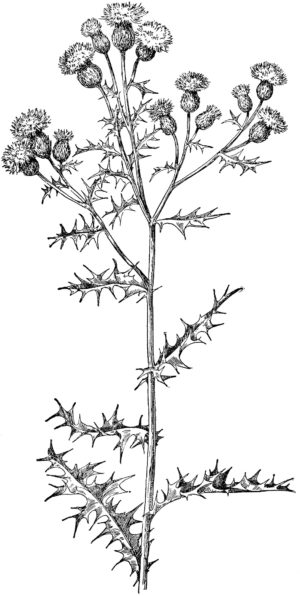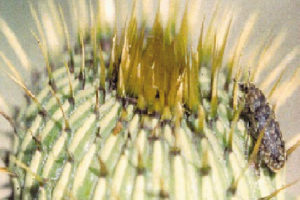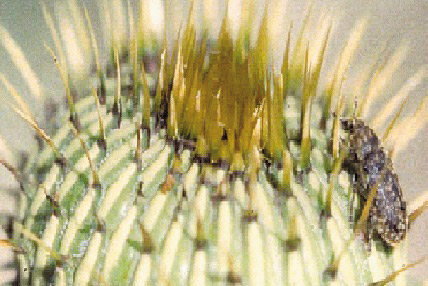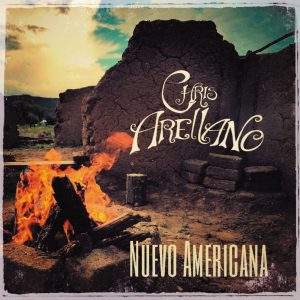 By Maisie Ramsay
By Maisie Ramsay
Consider the goldfinch. Spinus tristis flits about the countryside, its vibrant plumage imbued with arnica-blossom yellow. This wind-borne drop of gold can be found here in Chaffee County, fluttering from rural fence posts with the whimsy of a mountain breeze.
The finch makes lavish use of thistle, a plant whose prickly reputation belies its contributions to the animal kingdom. Thistle is a friend to the finch, and other creatures as well.
Pappas – down – from thistle heads are used to line goldfinch nests. Oil-rich thistle seeds contribute vital nutrients to finches’ vegetarian diet. Elsewhere in the animal kingdom, butterflies, bumblebees and hummingbirds sup upon thistle blossoms. Insects lay their eggs on thistle, a nursery for tender larvae. Even horses will eat the flowerheads of native thistle species.
Imagine this bounty virtually wiped out by the Eurasian thistlehead weevil, Rhinocyllus conicus. It was introduced to the United States in 1969, the same year the National Environmental Policy Act was crafted. This weevil was intended to eradicate the non-native, noxious thistle plaguing farms and ranches. At the time, it seemed like a benign alternative to toxic chemicals.
Enter the work of Salida resident Svata Louda, who has spent the better part of three decades conducting ecological research on the interplay of plants and insects. Her research demonstrated that the thistle-head weevil does not discriminate between native and non-native thistle species. Rhinocyllus conicus will eat pretty much any thistle it comes across. It feasts on noxious musk thistle, Canada thistle and bull thistle right along with native thistle species like the Platte thistle.
The weevil was intended to control noxious weeds. As it turns out, it was actually an indiscriminate epicure of all thistle species. The native Platte thistle is just as tasty to a Rhinocyllus conicus as the noxious Canada thistle. In spreading to native thistle, Rhinocyllus conicus became an invasive species in and of itself.
Preparing for Invasion
The Upper Arkansas River Valley is a living laboratory for scientists gathering data on a rare state of affairs: the status of a native plant before it’s overrun by a non-native insect.
 This summer, Wichita State University professor Leland Russell and his assistant have scoured the hills and dales of Chaffee County to study native Platte thistle, Cirsium canescens, a prickly, pale-flowered member of the Aster family. His study builds on Louda’s vast research at the University of Nebraska-Lincoln, where she led pioneering ecological studies on native thistle species.
This summer, Wichita State University professor Leland Russell and his assistant have scoured the hills and dales of Chaffee County to study native Platte thistle, Cirsium canescens, a prickly, pale-flowered member of the Aster family. His study builds on Louda’s vast research at the University of Nebraska-Lincoln, where she led pioneering ecological studies on native thistle species.
Platte thistle growing in this area of Colorado are unique because they are still free of the non-native thistle-head weevil, Rhinocyllus conicus. This weevil has made its way to Bassam Park and the eastern slope of Trout Creek Pass, but has not yet infiltrated the Upper Arkansas River Valley. The question is not whether the weevil will spread to the valley, but when.
“We’re getting pre-invasion data on the demography of the species so we can compare it to after the weevil gets here,” Russell said, during a summer visit to oversee the research project. It is a “rare opportunity” to examine how an invasion of non-native species develops.
The work could yield a scientific before-and-after snapshot; pre-invasion versus post-invasion. “If we can understand the process of invasion, that may help us mitigate the effects of invasive species,” Russell said.
The link between non-native species and the resulting ecological impacts are now well documented, in part thanks to researchers like Louda.
 That hasn’t always been the case. When Louda began her research in the early ‘80s, there was a more cavalier attitude toward using non-native species for “biological control.” “It started at the time when we were pouring DDT on everything,” Louda said. Advocates for using insects instead of chemicals “were genuinely concerned about the environment.”
That hasn’t always been the case. When Louda began her research in the early ‘80s, there was a more cavalier attitude toward using non-native species for “biological control.” “It started at the time when we were pouring DDT on everything,” Louda said. Advocates for using insects instead of chemicals “were genuinely concerned about the environment.”
The problem, as Louda’s research demonstrated, is that non-native species behave very differently when taken out of their normal environment.
Fourteen years after the release of Rhinocyllus conicus, Louda moved to the University of Nebraska-Lincoln, where she studied the effects of insect activity on the native Platte thistle.
As Louda recalled, those who advocated for the release of Rhinocyllus conicus argued the weevil would limit its activity to the same noxious species it fed upon in its natural environment. Instead, Louda’s research indicated that the thistle-head weevil targeted both native and non-native thistle species. This weevil is so ravenous that it has the potential to drive native thistle species into extinction – species like Pitcher’s thistle, which grows only on sandy shores along the upper Great Lakes. “We could demonstrate that this biocontrol agent that wasn’t supposed to feed on native plants was highly likely to drive native species into a zone of extinction,” Louda said.
When Louda began gathering data around Trout Creek Pass in 2005, “there were probably 100 plants over a quarter mile.” The weevil has obliterated Platte thistle species around Bassam Park and eastern Trout Creek Pass. “The weevil had started attacking and now it’s very hard for me to find 10 flowering plants to measure,” she said. “The plant population had crashed and the weevil loads were comparable to what I saw in the prairie.”
Louda did not set out to prove bad things about weevils. She simply followed where the research led.
“Ecologists try to be holistic. That’s what attracted me to the field,” Louda said. “I got fascinated by the questions and the idea of looking at multiple factors at the same time. I think every ecologist has some of that.”
In 1983, Louda began translating her California dissertation research into the Nebraska area to find a “local system,” a single species by which to study broader ecological functions. Her research required a native plant species that harbored vigorous insect activity, and the Platte thistle fit the bill.
“I didn’t go to work on thistles. I went to understand what is the ecology of the native vegetation,” Louda said. “You can’t work on everything, so you take a subset of species … and investigate how these connections are integrating and what are the consequences of those interactions numerically.”
The Platte thistle proved to be an ideal subject. Like most cirsium, the Platte thistle is monocarpic: It lives for years as a rosette before bolting, flowering once and dying. This allowed Louda to track the lifetime fitness of maternal plants. “The thistles were a system in which I could ask bigger questions,” she said.
[InContentAdTwo] The ability for vegetation to propagate is influenced by competition from other plants, climate-related effects of moisture and sun, plus the interaction of mammals, birds and insects – to mention a few. Louda examined these factors through thistle, studying them in the field and in the laboratory. Thistle were her lab mice.
Louda’s research studied the interaction between insect activity and Platte thistle populations. It was this line of inquiry that led to her findings about Rhinocyllus conicus’ impact on Platte thistle.
“One of the biocontrol agents moved onto Platte thistle on our study site,” Louda said. “It wasn’t just an accidental spillover. The insects were searching for something they could eat.” She had stumbled upon an out-of-control biological control. A beetle that was supposed to target noxious weeds was instead going after native plants.
Louda’s research offered a holistic perspective on the interplay of fauna and flora. Her findings also challenged assumptions about the safety of non-native biological control. She approached her research with discipline. The goal was not to affirm her assumptions, but instead to “eliminate hypotheses rather than confirm them.”
Louda’s research methodology and dogged persistence won her the respect of her peers, as well as a prestigious Mercer Award, continual National Science Foundation funding for her research and a chair at University of Nebraska-Lincoln. Though she retired in 2009, her work continues to be widely cited as research continues into the effects of Rhinocyllus conicus.
“Good science never leads to ‘I’m done.’” she said.
The Permaculture Solution
Svata, pronounced “svach-ya,” was born in the Czech Republic capital of Prague. She emigrated to the United States shortly thereafter, when her Czech parents and infant daughter fled the communist regime.
From their new home in southern California, Louda’s parents had her on skis by age two and downhill skis by seven. Skiing presented some obvious challenges when Louda moved to Nebraska. Her search for powder led to a membership with the Cornhuskers Ski Club, which made regular trips to Monarch Mountain. Louda met her husband, Rod Otley, through the club and the pair eventually settled in Salida.
From the dining table of her Salida home, Louda reflected on her legacy of research into the delicate interactions between plants, insects, birds, rodents and the rest of the natural system.
“Given our results, I’m really a strong proponent now of a subarea of biological control and that’s conservation biological control,” she said.
Conservation biological control is the augmentation of local, native species to address ecological problems like noxious weeds. Instead of using a non-native weevil to mitigate Canada thistle, for instance, conservation biological control might call for improving the soil and strengthening populations of native species that already feed on thistle.
Conservation biological control can look a lot like permaculture – sustainable farming methods that work in harmony with the local ecosystem.
Permaculture amounts to “following nature’s rules,” Louda said. “To me, that has to be the future of biological controls because we just cannot predict what nonnative species will do when introduced into a new environment.”
Louda has her own opinion about using non-native insects to control non-native plants. “It seems to me that we should consider everything else first.”
Maisie Ramsay writes from her unexpectedly verdant home in Poncha Springs, where she wrestles with a garden that has run amok. Anyone need kale?


